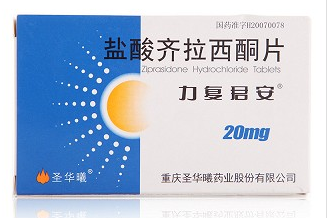Contact Us

Hebei Guotai Pharmaceutical Co., Ltd.
Business phone:0311-89937823
0311-89937822
QC telephone: 0311-89937810
Financial telephone: 0311-89937817
Office phone:0311-89937808
Website:http://www.hbgtyy.com
Address:No. 125 Songjiang Road, Shijiazhuang Economic and Technological Development Zone, Hebei Province
Ziprasidone Hydrochloride Tablets
作者:admin 时间:2018-11-21
[drug name]
General name: Ziprasidone Hydrochloride Tablets
Product Name: Li Fu Junan Ziprasidone Hydrochloride Tablets 20mg*20 tablets
Pinyin full code: LiFuJunAn YanSuanQiLaXiTongPian
[main ingredients]
The main ingredient of this product is ziprasidone hydrochloride. Chemical name: 5-[2-[4-(1,2-benzoisothiazole-3-yl) -1-piperazine] ethyl]-6-chloro-1,3-dihydro-2(1H) -indole-2-one hydrochloride monohydrate.
[character]
This product is white or light red.
Indications / indications
This product is suitable for the treatment of schizophrenia.
[specification type]
20mg*20 film
[usage and dosage]
Initial treatment: one 20mg (one tablet), two times a day, oral administration at meals. Depending on the condition, it can gradually increase to 80mg (four tablets) and two times a day. In order to ensure the lowest effective dose, we should carefully observe the reaction after the dosage adjustment. The interval of dosage adjustment should be no less than 2 days, because the blood concentration of the oral product reaches a stable state within 1-3 days.
Maintenance treatment: we should regularly assess and determine whether patients need maintenance treatment. Although the duration of ziprasidone maintenance therapy has not yet been determined, the effective dose of ziprasidone for schizophrenics in a 52-week clinical trial was 20-80 mg once and twice a day. Minimum effective dose should be used during maintenance therapy. In most cases, 20 mg ziprasidone twice a day is sufficient.
Drug use in special population: people of different ages, sexes, races, as well as patients with renal or liver function impairment, generally do not need to adjust the dosage.
[adverse reactions]
Sleepiness, inability to sit still, extravertebral symptoms, dizziness, dystonia, headache, gastrointestinal discomfort, weakness, excitement and hypertonia. A few cases showed elevated SGPT, skeletal muscle discomfort, abnormal central nervous system, rhinitis, maculopapular, rubella, abnormal vision and urinary incontinence.
[taboo]
Prolongation of 1.QT interval
Ziprasidone prolongs the QT interval in a dose-dependent manner, and has been shown to be associated with fatal arrhythmia in some drugs that prolong the QT interval. Ziprasidone was banned in patients with a history of prolonged QT interval (including congenital long QT interval syndrome), patients with recent acute myocardial infarction and patients with non-compensatory heart failure.
Ziprasidone contraindication is used in combination with drugs that can prolong the QT interval in pharmacodynamics, drugs that are contraindicated in prescription information for patients with prolonged QTc interval, and drugs with black-box warning for patients with prolonged QTc interval. Ziprasidone should not be associated with dofelide, sotalol, quinidine, other class Ia and III antiarrhythmic drugs, mesodazine, thialidazine, chlorpromazine, flupridol, pimozide, sparfloxacin, gatifloxacin, moxifloxacin, halofluoropan, mefloquine, pentamide, arsenic trioxide, levomethady. L acetate), methanesulfonic acid, and so on.
2. patients who are allergic to this product are prohibited.
[note]
Those who are prone to electrolyte disturbances (such as hypokalemia) need to correct the level of potassium and magnesium before medication. It should be used cautiously in the treatment of diuretics, cerebrovascular diseases, severe cardiovascular diseases, pituitary tumors, liver diseases and pregnant and lactating women. Stop the drug when the persistent QTc exceeds 500 milliseconds. Medication may affect the ability to drive and operate machinery. Avoid drinking. Please refer to the inner package instructions.
[drug interaction]
(1) ziprasidone can not be used in combination with prolonged QT interval. (2) Ziprasidone is mainly used in the central nervous system and should be used with caution in combination with other central active drugs. (3) ziprasidone can induce hypotension and enhance the efficacy of antihypertensive drugs. (4) ziprasidone antagonized levodopa and dopamine agonists. Please refer to the inner package instructions.
[child medication]
The safety and efficacy of ziprasidone in children are not yet evaluated.
[medication for elderly patients]
We should reduce the initial dose, slow adjust the dose, and closely monitor the patient.
[pregnancy and lactation medication]
Ziprasidone can only be used in pregnant women if the benefits of medication for pregnant women outweigh the potential risks to the fetus. It is not clear whether ziprasidone is secreted into breast milk. Women taking ziprasidone should not breast feed.
[drug overdose]
Human Drug Overdose Experience: In the pre-market clinical trials of 5400 patients or normal subjects, 10 patients accidentally or intentionally overused ziprasidone. All these patients recovered completely without sequelae. Patients who took the maximum dose of 3240 mg had only the following adverse reactions: mild sedation, unclear speech and transient hypertension (200/95). In post-marketing use, the most reported adverse reactions to ziprasidone overdose included extrapyramidal symptoms, sleepiness, tremor and anxiety. One case of patients who had been confirmed to take the maximum dose of ziprasidone after marketing was reported. The dose was 12800 mg. Extrapyramidal symptoms and prolonged QTc interval reached 446 milliseconds, but did not. There are sequelae of heart. Overdose: once there is an acute excess, establish and maintain ventilation to ensure adequate oxygen. Can be intravenous infusion or gastric lavage, if the patient does not wake up, can poke the tube, after poking the tube gastric lavage, consider laxative and activated carbon use together. Overdose may result in head and neck sensory retardation, seizures or dystonia, which may lead to inhalation



